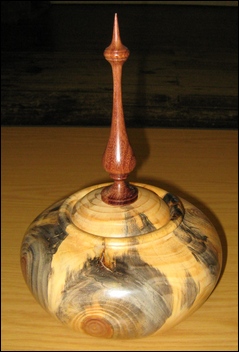Club Night Report
Wednesday 9th October 2013
An evening with John Berkeley - observations by Vernon Hughes
|
|
|
|
|
|
Small, but beautifully formed and expertly/ intriguingly made; may be said to sum up the products of John Berkeley's efforts during our October club night. John is a man of huge and longstanding reputation though and the fact that he is a master of thread cutting and miniature work would have been a surprise only to those newer members who are feeling their way into our great craft.
It seems best to start by calling attention to John's two websites: www.johnberkeley.co.uk and www.johnberkeley.biz . A visit to both of these is strongly recommended as will become obvious as soon as you make the hits. One of them includes a 6 minute video on thread chasing, which was one of his main subjects with us. You can buy Ashley Isles Unichasers from him which give a great saving, i.e. one modestly priced tool quite literally does the work of two! The websites also market and show how to make small and miniature tools; and as we saw on the night; he carries a wide range of tools, exceptional materials for turning, instructional DVDs, etc.
If you are unfortunate to purchase one with only a partial tooth it must be ground away. He said that the second complete tooth should be the first to make contact, and that once the thread has been started the tool will be pulled into the work. It must not be forced.
The second item made was a miniature, perfectly proportioned, highly detailed Victorian style candlestick and candle complete with protruding wick. Total length was no more than two X £1 coins high (probably less). The wick was stained black, the candle stem remained white and the stick was coloured in gold in the absence of a suitable brass stain; but it still looked perfect.
The third item was a tiny box with threaded lid in creamy 'Casein' (the nearest thing to real ivory). The cylinder blank must have been 5/8" to 3/4" in diameter. During this project he expanded on the 'uni-chaser'. The tool is used one way up for a male thread and simply turned over for the female thread. He emphasised that the armrest should be kept as close to the work as possible and pointed out how the free hand is positioned under the toolrest. One further very useful article in the toolkit was a partially threaded wooden stem, held in the chuck onto which the body of the box was screwed for detailed work.
 |
 |
 |
 |
Production continued with a miniature goblet complete with captive ring in red Casein (this was turned from a length of an old plastic knitting needle), polished with T-Cut, and then a tiny, tiny vase. For the latter he advised retaining pen blank offcuts and any other very small pieces of interesting timber that would usually be thrown away.
Some further points about tools and materials mentioned during the demonstrations were:
- Many small tools for miniature work can be self-fashioned-to-purpose using Allen keys (say for captive ring tools), Obo masonry nails for point tools, etc. (See his websites).
- Casein was once used in making the 'Conway Stewart' range of fountain pens.
- He 'sands' down to '1200' grit in abrasives.
- He strongly recommends the use of Point Tools and he explained some specifics in their use. They are perfect for crisp fine detail. Hold them as close as possible to the tip and avoid gripping the handle.
- 'Doctor' chucks for safety, by taking them to pieces and rounding off all edges that are exposed in use. This can make the difference between a bad cut and just a bruise!
- Sharpen parting tool tips at a very slight angle - to give a 'leading' edge, (presumably to achieve sharpness of cut in angles touched by the faintly protruding end of the tip).
<Top of Page>
The Show 'n' Tell theme for the evening was A Lidded Box - this was well supported with varied and interesting items on display.
 |
 |
 |
 |
 |
 |
 |
 |
 This month's winning entry is from Roger Jones - the timber is Spruce fir and the 6" tall finial is in Sapele - box is approx. 8" diameter by 6" high
|
<Top of Page>



